Hyundai Sonata Hybrid 2013 Owner's Manual
Manufacturer: HYUNDAI, Model Year: 2013, Model line: Sonata Hybrid, Model: Hyundai Sonata Hybrid 2013Pages: 425, PDF Size: 36.95 MB
Page 411 of 425
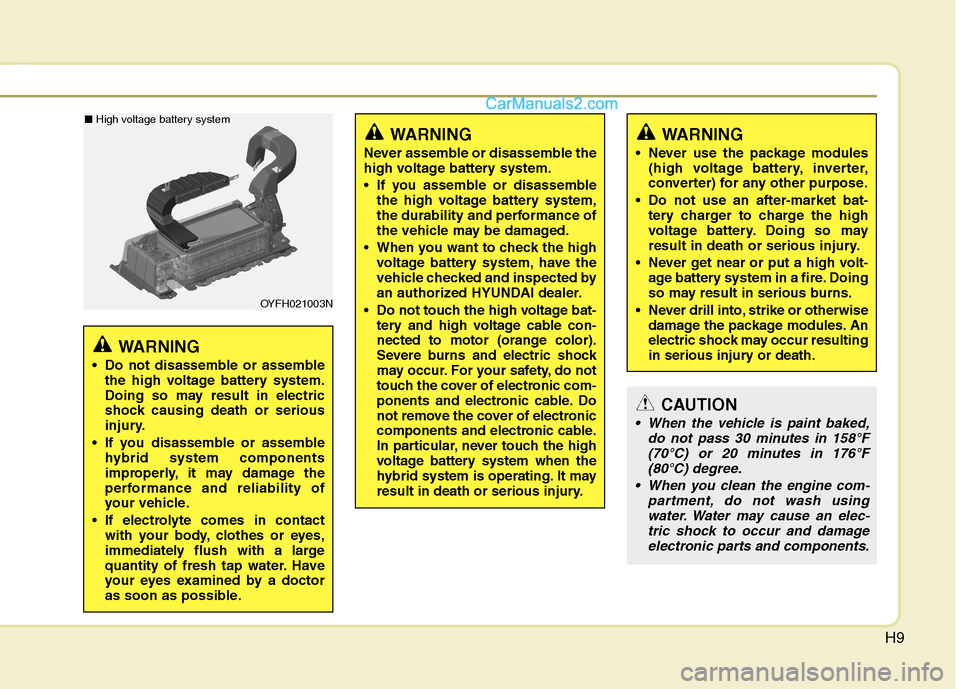
H9
WARNING
Do not disassemble or assemble
the high voltage battery system.
Doing so may result in electric
shock causing death or serious
injury.
If you disassemble or assemble
hybrid system components
improperly, it may damage the
performance and reliability of
your vehicle.
If electrolyte comes in contact
with your body, clothes or eyes,
immediately flush with a large
quantity of fresh tap water. Have
your eyes examined by a doctor
as soon as possible.
WARNING
Never assemble or disassemble the
high voltage battery system.
If you assemble or disassemble
the high voltage battery system,
the durability and performance of
the vehicle may be damaged.
When you want to check the high
voltage battery system, have the
vehicle checked and inspected by
an authorized HYUNDAI dealer.
Do not touch the high voltage bat-
tery and high voltage cable con-
nected to motor (orange color).
Severe burns and electric shock
may occur. For your safety, do not
touch the cover of electronic com-
ponents and electronic cable. Do
not remove the cover of electronic
components and electronic cable.
In particular, never touch the high
voltage battery system when the
hybrid system is operating. It may
result in death or serious injury.
OYFH021003N
WARNING
Never use the package modules
(high voltage battery, inverter,
converter) for any other purpose.
Do not use an after-market bat-
tery charger to charge the high
voltage battery. Doing so may
result in death or serious injury.
Never get near or put a high volt-
age battery system in a fire. Doing
so may result in serious burns.
Never drill into, strike or otherwise
damage the package modules. An
electric shock may occur resulting
in serious injury or death.
CAUTION
When the vehicle is paint baked,
do not pass 30 minutes in 158°F
(70°C) or 20 minutes in 176°F
(80°C) degree.
When you clean the engine com-
partment, do not wash using
water. Water may cause an elec-
tric shock to occur and damage
electronic parts and components.
■ High voltage battery system
Page 412 of 425
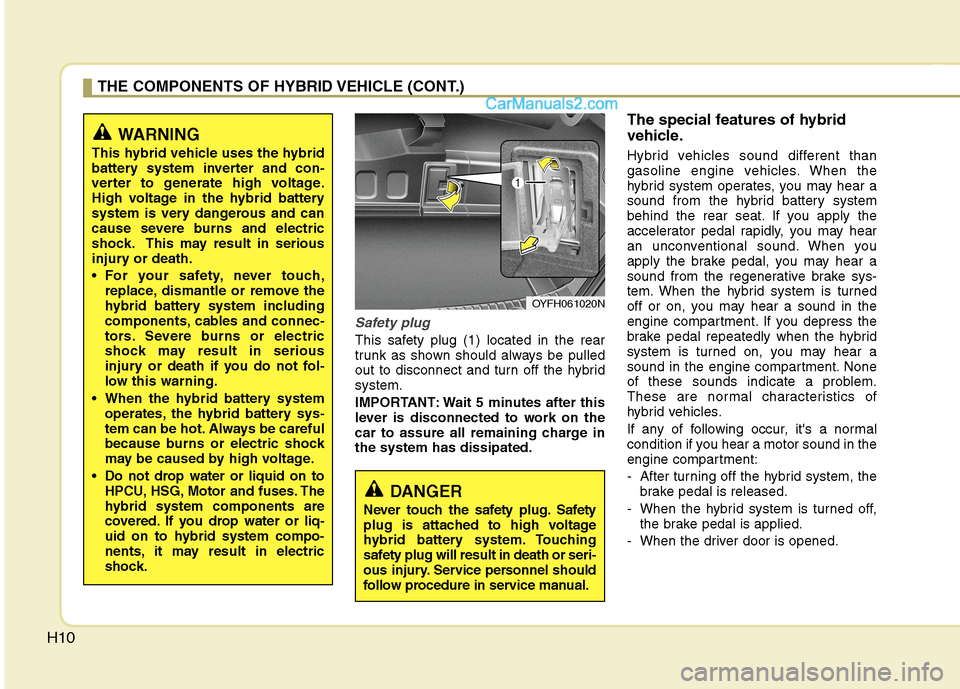
H10
Safety plug
This safety plug (1) located in the rear
trunk as shown should always be pulled
out to disconnect and turn off the hybrid
system.
IMPORTANT: Wait 5 minutes after this
lever is disconnected to work on the
car to assure all remaining charge in
the system has dissipated.
The special features of hybrid
vehicle.
Hybrid vehicles sound different than
gasoline engine vehicles. When the
hybrid system operates, you may hear a
sound from the hybrid battery system
behind the rear seat. If you apply the
accelerator pedal rapidly, you may hear
an unconventional sound. When you
apply the brake pedal, you may hear a
sound from the regenerative brake sys-
tem. When the hybrid system is turned
off or on, you may hear a sound in the
engine compartment. If you depress the
brake pedal repeatedly when the hybrid
system is turned on, you may hear a
sound in the engine compartment. None
of these sounds indicate a problem.
These are normal characteristics of
hybrid vehicles.
If any of following occur, it's a normal
condition if you hear a motor sound in the
engine compartment:
- After turning off the hybrid system, the
brake pedal is released.
- When the hybrid system is turned off,
the brake pedal is applied.
- When the driver door is opened.
THE COMPONENTS OF HYBRID VEHICLE (CONT.)
WARNING
This hybrid vehicle uses the hybrid
battery system inverter and con-
verter to generate high voltage.
High voltage in the hybrid battery
system is very dangerous and can
cause severe burns and electric
shock. This may result in serious
injury or death.
For your safety, never touch,
replace, dismantle or remove the
hybrid battery system including
components, cables and connec-
tors. Severe burns or electric
shock may result in serious
injury or death if you do not fol-
low this warning.
When the hybrid battery system
operates, the hybrid battery sys-
tem can be hot. Always be careful
because burns or electric shock
may be caused by high voltage.
Do not drop water or liquid on to
HPCU, HSG, Motor and fuses. The
hybrid system components are
covered. If you drop water or liq-
uid on to hybrid system compo-
nents, it may result in electric
shock.
DANGER
Never touch the safety plug. Safety
plug is attached to high voltage
hybrid battery system. Touching
safety plug will result in death or seri-
ous injury. Service personnel should
follow procedure in service manual.
OYFH061020N
Page 413 of 425
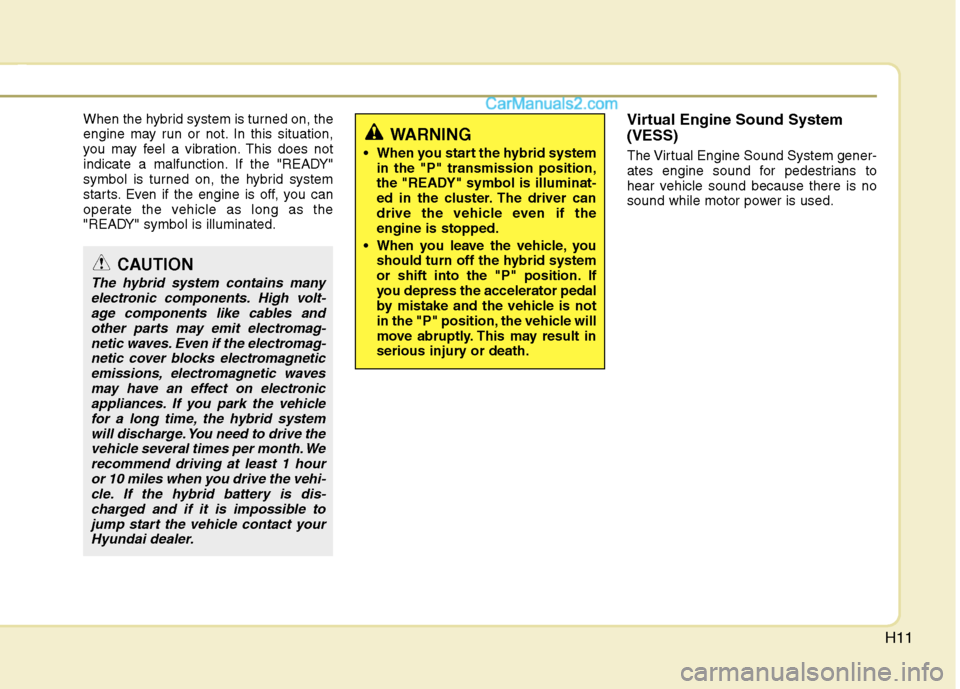
H11
When the hybrid system is turned on, the
engine may run or not. In this situation,
you may feel a vibration. This does not
indicate a malfunction. If the "READY"
symbol is turned on, the hybrid system
starts. Even if the engine is off, you can
operate the vehicle as long as the
"READY" symbol is illuminated.Virtual Engine Sound System
(VESS)
The Virtual Engine Sound System gener-
ates engine sound for pedestrians to
hear vehicle sound because there is no
sound while motor power is used.
WARNING
When you start the hybrid system
in the "P" transmission position,
the "READY" symbol is illuminat-
ed in the cluster. The driver can
drive the vehicle even if the
engine is stopped.
When you leave the vehicle, you
should turn off the hybrid system
or shift into the "P" position. If
you depress the accelerator pedal
by mistake and the vehicle is not
in the "P" position, the vehicle will
move abruptly. This may result in
serious injury or death.
CAUTION
The hybrid system contains many
electronic components. High volt-
age components like cables and
other parts may emit electromag-
netic waves. Even if the electromag-
netic cover blocks electromagnetic
emissions, electromagnetic waves
may have an effect on electronic
appliances. If you park the vehicle
for a long time, the hybrid system
will discharge. You need to drive the
vehicle several times per month. We
recommend driving at least 1 hour
or 10 miles when you drive the vehi-
cle. If the hybrid battery is dis-
charged and if it is impossible to
jump start the vehicle contact your
Hyundai dealer.
Page 414 of 425
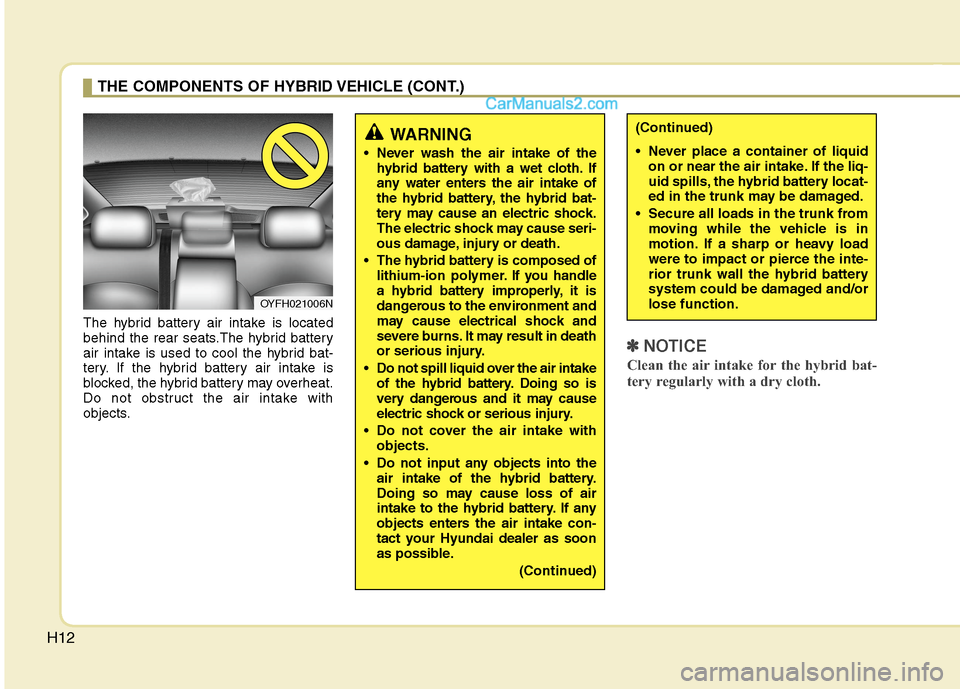
H12
The hybrid battery air intake is located
behind the rear seats.The hybrid battery
air intake is used to cool the hybrid bat-
tery. If the hybrid battery air intake is
blocked, the hybrid battery may overheat.
Do not obstruct the air intake with
objects.
✽ ✽
NOTICE
Clean the air intake for the hybrid bat-
tery regularly with a dry cloth.
THE COMPONENTS OF HYBRID VEHICLE (CONT.)
WARNING
Never wash the air intake of the
hybrid battery with a wet cloth. If
any water enters the air intake of
the hybrid battery, the hybrid bat-
tery may cause an electric shock.
The electric shock may cause seri-
ous damage, injury or death.
The hybrid battery is composed of
lithium-ion polymer. If you handle
a hybrid battery improperly, it is
dangerous to the environment and
may cause electrical shock and
severe burns. It may result in death
or serious injury.
Do not spill liquid over the air intake
of the hybrid battery. Doing so is
very dangerous and it may cause
electric shock or serious injury.
Do not cover the air intake with
objects.
Do not input any objects into the
air intake of the hybrid battery.
Doing so may cause loss of air
intake to the hybrid battery. If any
objects enters the air intake con-
tact your Hyundai dealer as soon
as possible.
(Continued)
(Continued)
Never place a container of liquid
on or near the air intake. If the liq-
uid spills, the hybrid battery locat-
ed in the trunk may be damaged.
Secure all loads in the trunk from
moving while the vehicle is in
motion. If a sharp or heavy load
were to impact or pierce the inte-
rior trunk wall the hybrid battery
system could be damaged and/or
lose function.
OYFH021006N
Page 415 of 425
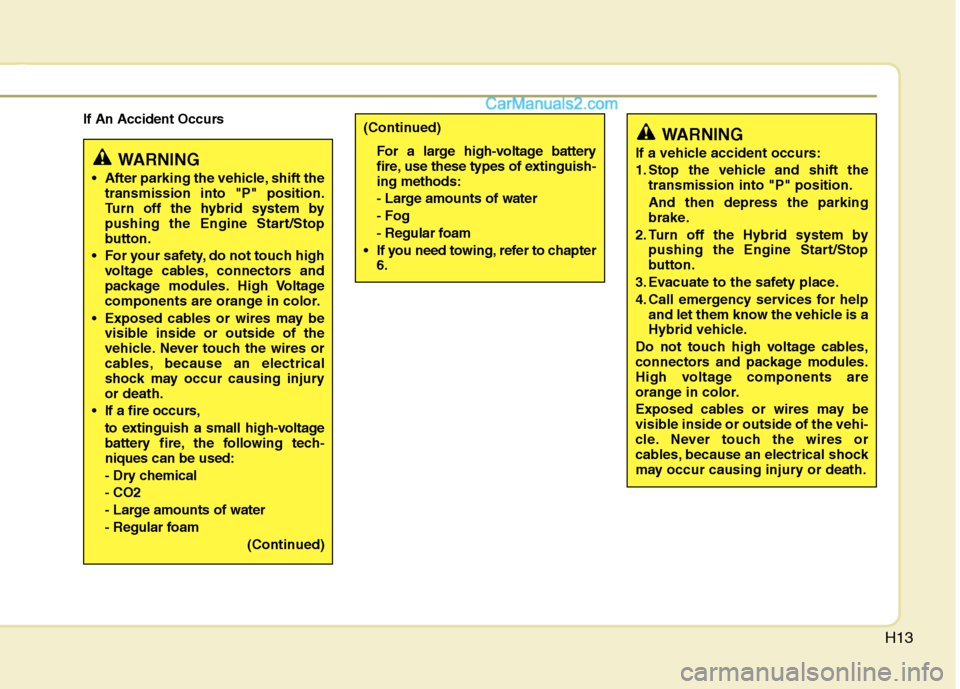
H13
If An Accident Occurs
WARNING
After parking the vehicle, shift the
transmission into "P" position.
Turn off the hybrid system by
pushing the Engine Start/Stop
button.
For your safety, do not touch high
voltage cables, connectors and
package modules. High Voltage
components are orange in color.
Exposed cables or wires may be
visible inside or outside of the
vehicle. Never touch the wires or
cables, because an electrical
shock may occur causing injury
or death.
If a fire occurs,
to extinguish a small high-voltage
battery fire, the following tech-
niques can be used:
- Dry chemical
- CO2
- Large amounts of water
- Regular foam
(Continued)
WARNING
If a vehicle accident occurs:
1. Stop the vehicle and shift the
transmission into "P" position.
And then depress the parking
brake.
2. Turn off the Hybrid system by
pushing the Engine Start/Stop
button.
3. Evacuate to the safety place.
4. Call emergency services for help
and let them know the vehicle is a
Hybrid vehicle.
Do not touch high voltage cables,
connectors and package modules.
High voltage components are
orange in color.
Exposed cables or wires may be
visible inside or outside of the vehi-
cle. Never touch the wires or
cables, because an electrical shock
may occur causing injury or death.
(Continued)
For a large high-voltage battery
fire, use these types of extinguish-
ing methods:
- Large amounts of water
- Fog
- Regular foam
If you need towing, refer to chapter
6.
Page 416 of 425
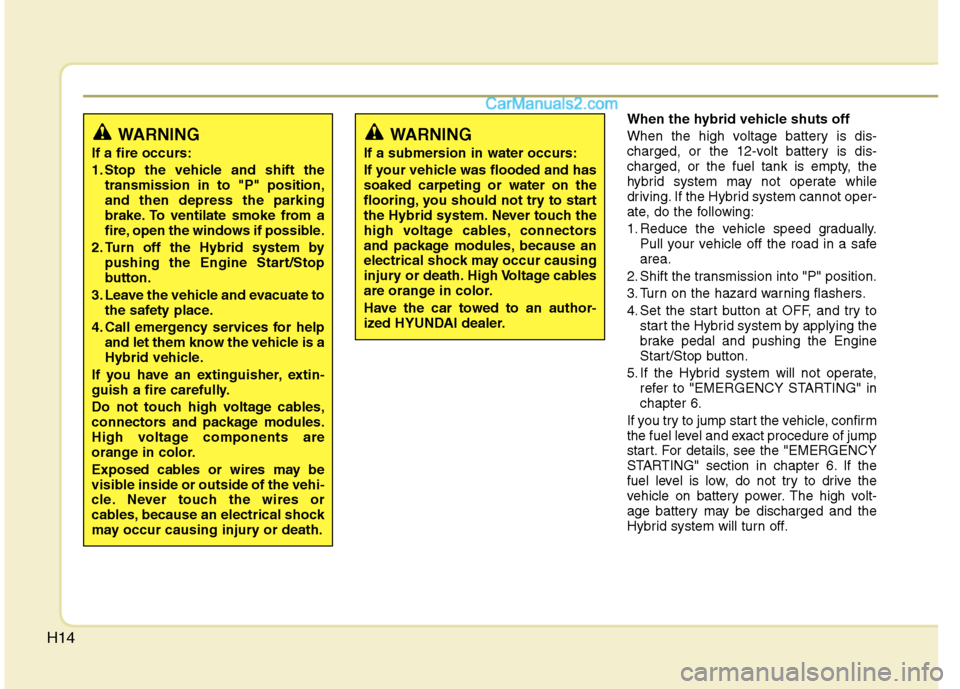
H14
When the hybrid vehicle shuts off
When the high voltage battery is dis-
charged, or the 12-volt battery is dis-
charged, or the fuel tank is empty, the
hybrid system may not operate while
driving. If the Hybrid system cannot oper-
ate, do the following:
1. Reduce the vehicle speed gradually.
Pull your vehicle off the road in a safe
area.
2. Shift the transmission into "P" position.
3. Turn on the hazard warning flashers.
4. Set the start button at OFF, and try to
start the Hybrid system by applying the
brake pedal and pushing the Engine
Start/Stop button.
5. If the Hybrid system will not operate,
refer to "EMERGENCY STARTING" in
chapter 6.
If you try to jump start the vehicle, confirm
the fuel level and exact procedure of jump
start. For details, see the "EMERGENCY
STARTING" section in chapter 6. If the
fuel level is low, do not try to drive the
vehicle on battery power. The high volt-
age battery may be discharged and the
Hybrid system will turn off.
WARNING
If a fire occurs:
1. Stop the vehicle and shift the
transmission in to "P" position,
and then depress the parking
brake. To ventilate smoke from a
fire, open the windows if possible.
2. Turn off the Hybrid system by
pushing the Engine Start/Stop
button.
3. Leave the vehicle and evacuate to
the safety place.
4. Call emergency services for help
and let them know the vehicle is a
Hybrid vehicle.
If you have an extinguisher, extin-
guish a fire carefully.
Do not touch high voltage cables,
connectors and package modules.
High voltage components are
orange in color.
Exposed cables or wires may be
visible inside or outside of the vehi-
cle. Never touch the wires or
cables, because an electrical shock
may occur causing injury or death.
WARNING
If a submersion in water occurs:
If your vehicle was flooded and has
soaked carpeting or water on the
flooring, you should not try to start
the Hybrid system. Never touch the
high voltage cables, connectors
and package modules, because an
electrical shock may occur causing
injury or death. High Voltage cables
are orange in color.
Have the car towed to an author-
ized HYUNDAI dealer.
Page 417 of 425
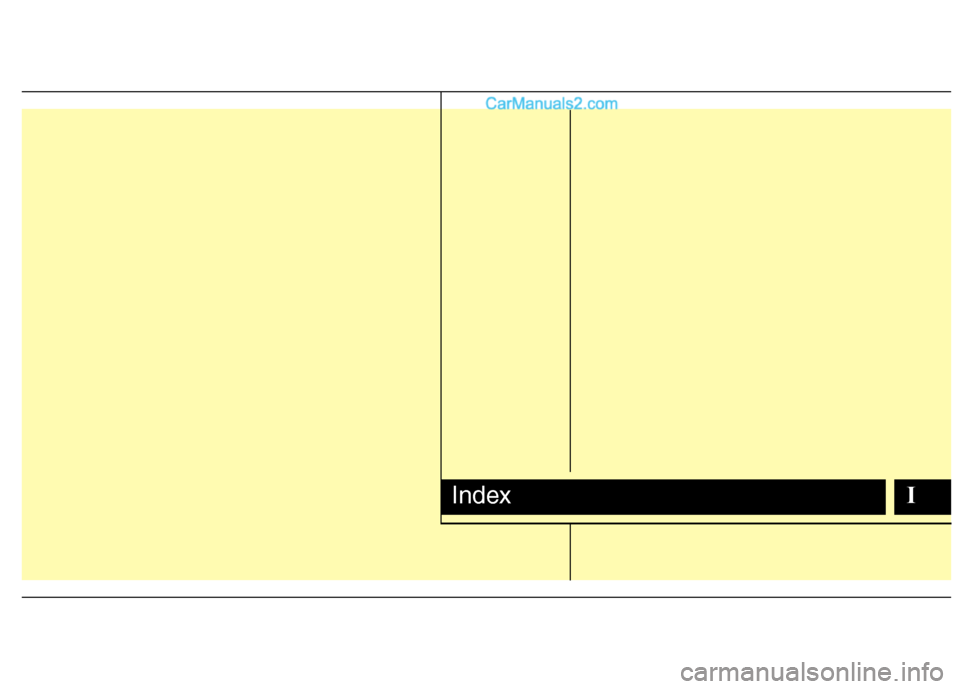
IIndex
Page 418 of 425
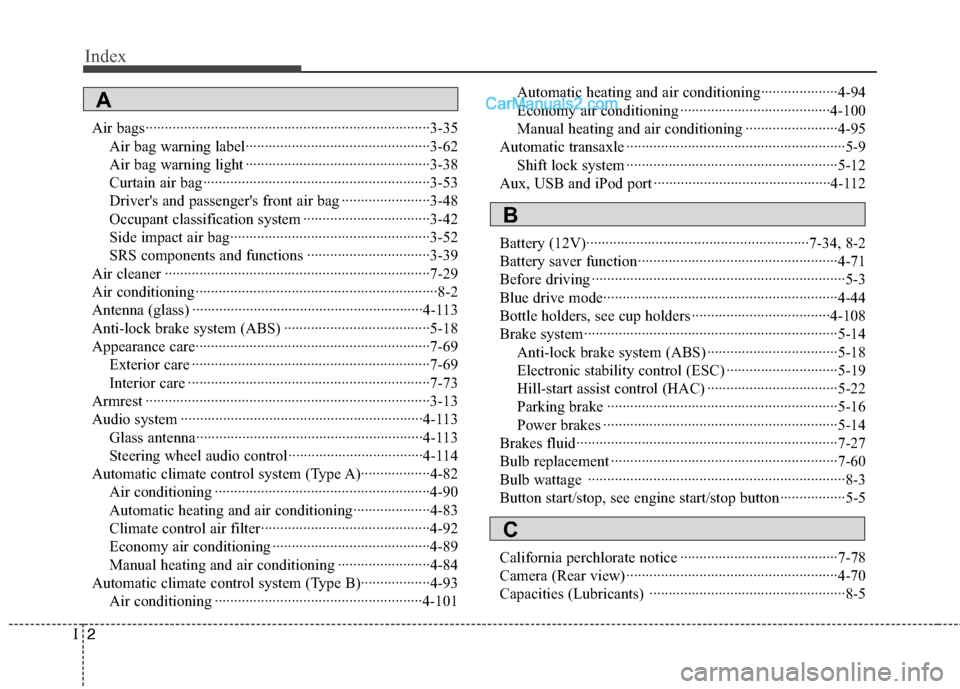
Index
2I
Air bags··········································································3-35
Air bag warning label················································3-62
Air bag warning light ················································3-38
Curtain air bag···························································3-53
Driver's and passenger's front air bag ·······················3-48
Occupant classification system ·································3-42
Side impact air bag····················································3-52
SRS components and functions ································3-39
Air cleaner ·····································································7-29
Air conditioning ·······························································8-2
Antenna (glass) ····························································4-113
Anti-lock brake system (ABS) ······································5-18
Appearance care·····························································7-69
Exterior care ······························································7-69
Interior care ·······························································7-73
Armrest ··········································································3-13
Audio system ·······························································4-113
Glass antenna···························································4-113
Steering wheel audio control···································4-114
Automatic climate control system (Type A)··················4-82
Air conditioning ························································4-90
Automatic heating and air conditioning····················4-83
Climate control air filter············································4-92
Economy air conditioning ·········································4-89
Manual heating and air conditioning ························4-84
Automatic climate control system (Type B)··················4-93
Air conditioning ······················································4-101Automatic heating and air conditioning····················4-94
Economy air conditioning ·······································4-100
Manual heating and air conditioning ························4-95
Automatic transaxle ·························································5-9
Shift lock system ·······················································5-12
Aux, USB and iPod port ··············································4-112
Battery (12V)··························································7-34, 8-2
Battery saver function····················································4-71
Before driving ··································································5-3
Blue drive mode·····························································4-44
Bottle holders, see cup holders ····································4-108
Brake system··································································5-14
Anti-lock brake system (ABS) ··································5-18
Electronic stability control (ESC) ·····························5-19
Hill-start assist control (HAC) ··································5-22
Parking brake ····························································5-16
Power brakes ·····························································5-14
Brakes fluid····································································7-27
Bulb replacement ···························································7-60
Bulb wattage ···································································8-3
Button start/stop, see engine start/stop button·················5-5
California perchlorate notice ·········································7-78
Camera (Rear view) ·······················································4-70
Capacities (Lubricants) ···················································8-5
A
B
C
Page 419 of 425
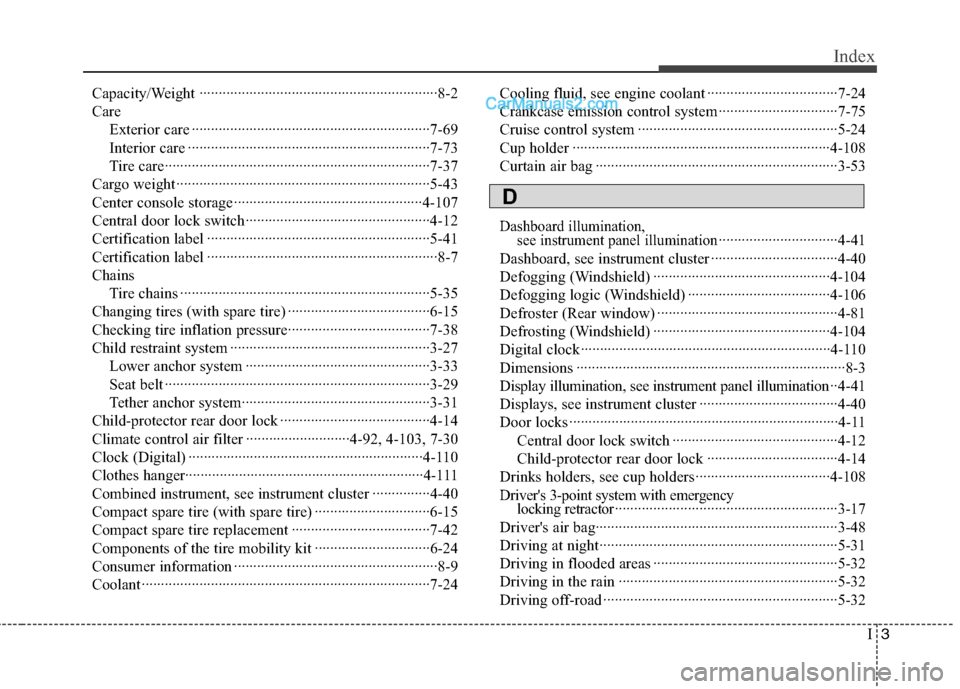
I3
Index
Capacity/Weight ······························································8-2
Care
Exterior care ······························································7-69
Interior care ·······························································7-73
Tire care·····································································7-37
Cargo weight ··································································5-43
Center console storage ·················································4-107
Central door lock switch················································4-12
Certification label ··························································5-41
Certification label ····························································8-7
Chains
Tire chains ·································································5-35
Changing tires (with spare tire) ·····································6-15
Checking tire inflation pressure·····································7-38
Child restraint system ····················································3-27
Lower anchor system ················································3-33
Seat belt ·····································································3-29
Tether anchor system·················································3-31
Child-protector rear door lock ·······································4-14
Climate control air filter ···························4-92, 4-103, 7-30
Clock (Digital) ·····························································4-110
Clothes hanger······························································4-111
Combined instrument, see instrument cluster ···············4-40
Compact spare tire (with spare tire) ······························6-15
Compact spare tire replacement ····································7-42
Components of the tire mobility kit ······························6-24
Consumer information ·····················································8-9
Coolant ···········································································7-24Cooling fluid, see engine coolant ··································7-24
Crankcase emission control system ·······························7-75
Cruise control system ····················································5-24
Cup holder ···································································4-108
Curtain air bag ·······························································3-53
Dashboard illumination,
see instrument panel illumination·······························4-41
Dashboard, see instrument cluster ·································4-40
Defogging (Windshield) ··············································4-104
Defogging logic (Windshield) ·····································4-106
Defroster (Rear window) ···············································4-81
Defrosting (Windshield) ··············································4-104
Digital clock·································································4-110
Dimensions ······································································8-3
Display illumination, see instrument panel illumination··4-41
Displays, see instrument cluster ····································4-40
Door locks ······································································4-11
Central door lock switch ···········································4-12
Child-protector rear door lock ··································4-14
Drinks holders, see cup holders···································4-108
Driver's 3-point system with emergency
locking retractor··························································3-17
Driver's air bag·······························································3-48
Driving at night······························································5-31
Driving in flooded areas ················································5-32
Driving in the rain ·························································5-32
Driving off-road ·····························································5-32
D
Page 420 of 425
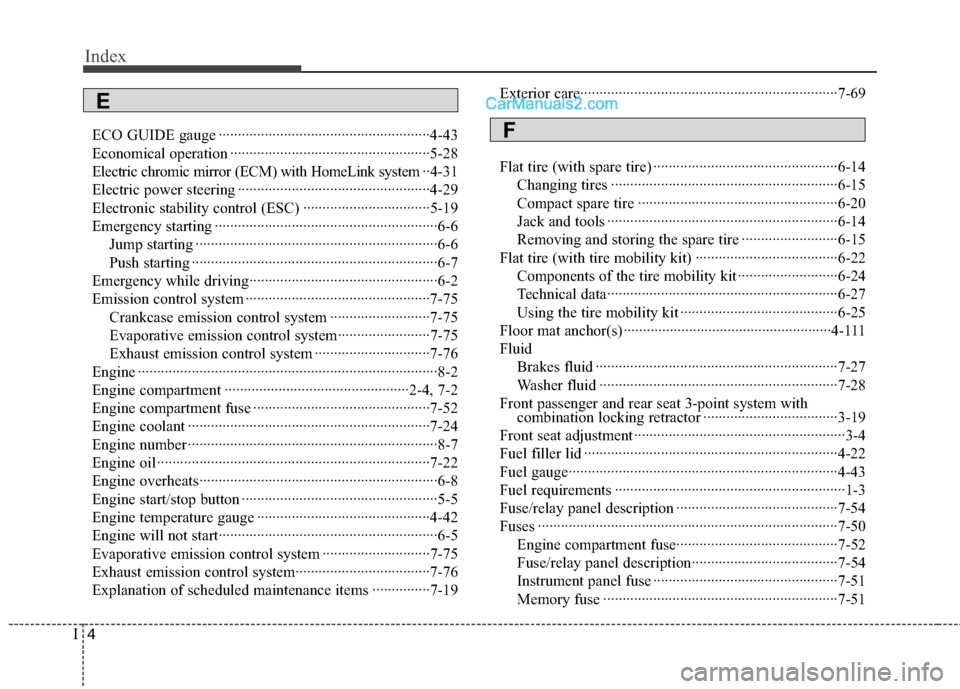
Index
4I
ECO GUIDE gauge ·······················································4-43
Economical operation ····················································5-28
Electric chromic mirror (ECM) with HomeLink system··4-31
Electric power steering ··················································4-29
Electronic stability control (ESC) ·································5-19
Emergency starting ··························································6-6
Jump starting ·······························································6-6
Push starting ································································6-7
Emergency while driving·················································6-2
Emission control system ················································7-75
Crankcase emission control system ··························7-75
Evaporative emission control system························7-75
Exhaust emission control system ······························7-76
Engine ··············································································8-2
Engine compartment ················································2-4, 7-2
Engine compartment fuse ··············································7-52
Engine coolant ·······························································7-24
Engine number ·································································8-7
Engine oil ·······································································7-22
Engine overheats······························································6-8
Engine start/stop button ···················································5-5
Engine temperature gauge ·············································4-42
Engine will not start·························································6-5
Evaporative emission control system ····························7-75
Exhaust emission control system···································7-76
Explanation of scheduled maintenance items ···············7-19Exterior care···································································7-69
Flat tire (with spare tire) ················································6-14
Changing tires ···························································6-15
Compact spare tire ····················································6-20
Jack and tools ····························································6-14
Removing and storing the spare tire ·························6-15
Flat tire (with tire mobility kit) ·····································6-22
Components of the tire mobility kit ··························6-24
Technical data····························································6-27
Using the tire mobility kit ·········································6-25
Floor mat anchor(s) ······················································4-111
Fluid
Brakes fluid ·······························································7-27
Washer fluid ······························································7-28
Front passenger and rear seat 3-point system with
combination locking retractor ···································3-19
Front seat adjustment ·······················································3-4
Fuel filler lid ··································································4-22
Fuel gauge······································································4-43
Fuel requirements ····························································1-3
Fuse/relay panel description ··········································7-54
Fuses ··············································································7-50
Engine compartment fuse··········································7-52
Fuse/relay panel description······································7-54
Instrument panel fuse ················································7-51
Memory fuse ·····························································7-51
E
F